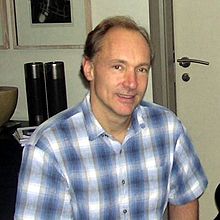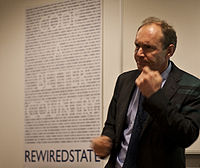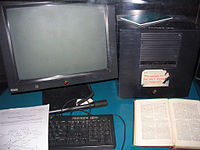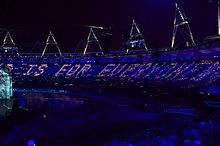
Tim Berners-Lee
Background Information
This wikipedia selection has been chosen by volunteers helping SOS Children from Wikipedia for this Wikipedia Selection for schools. SOS mothers each look after a a family of sponsored children.
| Sir Tim Berners-Lee | |
|---|---|
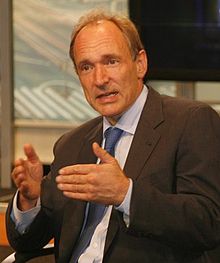 Berners-Lee in 2008 |
|
| Born | Timothy John Berners-Lee 8 June 1955 London, England United Kingdom |
| Residence | United States and United Kingdom |
| Nationality | British |
| Alma mater | Queen's College, Oxford |
| Occupation | Computer scientist |
| Employer |
|
| Known for |
|
| Title | Professor |
| Religion | Unitarian Universalism |
| Parents | Conway Berners-Lee Mary Lee Woods |
| Website | |
| www.w3.org/People/Berners-Lee/ | |
Sir Timothy John "Tim" Berners-Lee, OM, KBE, FRS, FREng, FRSA (born 8 June 1955), also known as "TimBL," is a British computer scientist, best known as the inventor of the World Wide Web. He made a proposal for an information management system in March 1989, and he implemented the first successful communication between a Hypertext Transfer Protocol (HTTP) client and server via the Internet sometime around mid November.
Berners-Lee is the director of the World Wide Web Consortium (W3C), which oversees the Web's continued development. He is also the founder of the World Wide Web Foundation, and is a senior researcher and holder of the Founders Chair at the MIT Computer Science and Artificial Intelligence Laboratory (CSAIL). He is a director of the Web Science Research Initiative (WSRI), and a member of the advisory board of the MIT Centre for Collective Intelligence.
In 2004, Berners-Lee was knighted by Queen Elizabeth II for his pioneering work. In April 2009, he was elected a foreign associate of the United States National Academy of Sciences. He was honoured as the "Inventor of the World Wide Web" during the 2012 Summer Olympics opening ceremony, in which he appeared in person, working at a NeXT Computer at the London Olympic Stadium. He tweeted "This is for everyone", which was instantly spelled out in LCD lights attached to the chairs of the 80,000 people in the audience.
Early life
Berners-Lee was born in southwest London, England, on 8 June 1955, one of four children born to Conway Berners-Lee and Mary Lee Woods. His parents worked on the first commercially-built computer, the Ferranti Mark 1. He attended Sheen Mount Primary School, and then went on to attend south west London's independent Emanuel School from 1969 to 1973. A keen trainspotter as a child, he learnt about electronics from tinkering with a model railway. He studied at Queen's College, Oxford, from 1973 to 1976, where he received a first-class degree in physics.
Career
After graduation he worked as an engineer at the telecommunications company Plessey in Poole. In 1978 he joined D. G. Nash in Dorset where he helped create type-setting software for printers.
Berners-Lee worked as an independent contractor at CERN from June to December 1980. While there, he proposed a project based on the concept of hypertext, to facilitate sharing and updating information among researchers. To demonstrate, he built a prototype system named ENQUIRE.
After leaving CERN in late 1980, he went to work at John Poole's Image Computer Systems, Ltd, in Bournemouth, England. He ran the company's technical side for three years. The project he worked on was a real-time remote procedure call which gave him experience in computer networking. In 1984, he returned to CERN as a fellow.
In 1989, CERN was the largest Internet node in Europe, and Berners-Lee saw an opportunity to join hypertext with the Internet: "I just had to take the hypertext idea and connect it to the Transmission Control Protocol and domain name system ideas and—ta-da!—the World Wide Web ... Creating the web was really an act of desperation, because the situation without it was very difficult when I was working at CERN later. Most of the technology involved in the web, like the hypertext, like the Internet, multifont text objects, had all been designed already. I just had to put them together. It was a step of generalising, going to a higher level of abstraction, thinking about all the documentation systems out there as being possibly part of a larger imaginary documentation system.”
Berners-Lee wrote his initial proposal in March 1989, and in 1990, with the help of Robert Cailliau (with whom he shared the 1995 ACM Software System Award), produced a revision which was accepted by his manager, Mike Sendall. He used similar ideas to those underlying the ENQUIRE system to create the World Wide Web, for which he designed and built the first Web browser. This also functioned as an editor ( WorldWideWeb, running on the NeXTSTEP operating system), and the first Web server, CERN HTTPd (short for Hypertext Transfer Protocol daemon).
" Mike Sendall buys a NeXT cube for evaluation, and gives it to Tim [Berners-Lee]. Tim's prototype implementation on NeXTStep is made in the space of a few months, thanks to the qualities of the NeXTStep software development system. This prototype offers WYSIWYG browsing/authoring! Current Web browsers used in "surfing the Internet" are mere passive windows, depriving the user of the possibility to contribute. During some sessions in the CERN cafeteria, Tim and I try to find a catching name for the system. I was determined that the name should not yet again be taken from Greek mythology. Tim proposes "World-Wide Web". I like this very much, except that it is difficult to pronounce in French..." by Robert Cailliau, 2 November 1995.
The first website built was at CERN within the border of France, and was first put online on 6 August 1991:
Info.cern.ch was the address of the world's first-ever web site and web server, running on a NeXT computer at CERN. The first web page address was http://info.cern.ch/hypertext/WWW/TheProject.html, which centred on information regarding the WWW project. Visitors could learn more about hypertext, technical details for creating their own webpage, and even an explanation on how to search the Web for information. There are no screenshots of this original page and, in any case, changes were made daily to the information available on the page as the WWW project developed. You may find a later copy (1992) on the World Wide Web Consortium website.
It provided an explanation of what the World Wide Web was, and how one could use a browser and set up a web server.
In 1994, Berners-Lee founded the W3C at MIT. It comprised various companies that were willing to create standards and recommendations to improve the quality of the Web. Berners-Lee made his idea available freely, with no patent and no royalties due. The World Wide Web Consortium decided that its standards should be based on royalty-free technology, so that they could easily be adopted by anyone.
In 2001, Berners-Lee became a patron of the East Dorset Heritage Trust, having previously lived in Colehill in Wimborne, East Dorset, England.
In December 2004, he accepted a chair in Computer Science at the School of Electronics and Computer Science, University of Southampton, England, to work on the Semantic Web.
In a Times article in October 2009, Berners-Lee admitted that the initial pair of slashes ("//") in a web address were actually "unnecessary". He told the newspaper that he could easily have designed URLs not to have the slashes. "There you go, it seemed like a good idea at the time," he said in his lighthearted apology.
Current work
In June 2009 then British Prime Minister Gordon Brown announced Berners-Lee would work with the UK Government to help make data more open and accessible on the Web, building on the work of the Power of Information Task Force. Berners-Lee and Professor Nigel Shadbolt are the two key figures behind data.gov.uk, a UK Government project to open up almost all data acquired for official purposes for free re-use. Commenting on the opening up of Ordnance Survey data in April 2010 Berners-Lee said that: "The changes signal a wider cultural change in Government based on an assumption that information should be in the public domain unless there is a good reason not to—not the other way around." He went on to say "Greater openness, accountability and transparency in Government will give people greater choice and make it easier for individuals to get more directly involved in issues that matter to them."
In November 2009, Berners-Lee launched the World Wide Web Foundation in order to "Advance the Web to empower humanity by launching transformative programs that build local capacity to leverage the Web as a medium for positive change."
Berners-Lee is one of the pioneer voices in favour of Net Neutrality, and has expressed the view that ISPs should supply "connectivity with no strings attached," and should neither control nor monitor customers' browsing activities without their expressed consent. He advocates the idea that net neutrality is a kind of human network right: "Threats to the Internet, such as companies or governments that interfere with or snoop on Internet traffic, compromise basic human network rights."
Berners-Lee is President of the Open Data Institute.
Recognition
- In 1994 he became one of only six members of the World Wide Web Hall of Fame.
- In 1995 he won the Kilby Foundation's "Young Innovator of the Year" Award.
- In 1995 he received also the Software System Award from the Association for Computing Machinery (ACM).
- In the 1997 Queen's Birthday Honours he was appointed an Officer of the Order of the British Empire (OBE) "for services to global computer networking".
- In 1998 he was awarded with an honorary doctorate from the University of Essex.
- In 1999, Time Magazine named Berners-Lee one of the 100 Most Important People of the 20th century.
- In March 2000 he was awarded an honorary degree from The Open University as Doctor of the University.
- In 2001, he was elected a Fellow of the American Academy of Arts and Sciences.
- In 2002, he was named in the BBC's list of the 100 Greatest Britons following a UK-wide vote.
- In 2003 he was awarded The Royal Photographic Society's Progress Medal and Honorary Fellowship (HonFRPS) in recognition of any invention, research, publication or other contribution which has resulted in an important advance in the scientific or technological development of photography or imaging in the widest sense.
- In 2003, he received the Computer History Museum's Fellow Award, for his seminal contributions to the development of the World Wide Web.
- On 15 April 2004, he was named as the first recipient of Finland's Millennium Technology Prize, for inventing the World Wide Web. The cash prize, worth one million euros (about £892,000, or US$1.3 million, as of Sept 2011), was awarded on 15 June, in Helsinki, Finland, by the President of the Republic of Finland, Tarja Halonen.
- He received a knighthood in 2004 when he was promoted to Knight Commander of the Order of the British Empire (KBE) in the New Year Honours "for services to the global development of the Internet", and was formally invested on 16 July 2004.
- On 21 July 2004, he was presented with an honorary Doctor of Science degree from Lancaster University.
- On 27 January 2005, he was named Greatest Briton of 2004, both for his achievements and for displaying the key British characteristics of "diffidence, determination, a sharp sense of humour and adaptability", as put by David Hempleman-Adams, a panel member.
- In 2007, Berners-Lee received the Academy of Achievement's Golden Plate Award.
- In 2007, he was ranked Joint First, alongside Albert Hofmann, in The Telegraph's list of 100 greatest living geniuses.
- On 13 June 2007, he received the Order of Merit, becoming one of only 24 living members entitled to hold the honour, and to use the post-nominals 'O.M.' after their name. (The Order of Merit is within the personal bestowal of The Queen, and does not require recommendation by ministers or the Prime Minister)
- He was awarded the 2008 IEEE/RSE Wolfson James Clerk Maxwell Award, for "conceiving and further developing the World Wide Web".
- On 2 December 2008, Berners-Lee was awarded an honorary doctorate from the University of Manchester. His parents worked on the Manchester Mark 1 in the 1940s and 50s.
- On 21 April 2009, he was awarded an honorary doctorate by the Universidad Politécnica de Madrid.
- On 28 April 2009, he was elected a foreign associate of the United States National Academy of Sciences.
- On 8 June 2009, he received the Webby Award for Lifetime Achievement, at the awards ceremony held in New York City.
- In October 2009, he was awarded an honorary doctorate by the Vrije Universiteit Amsterdam
- On 30 March 2011, he was one of the first three recipients of the Mikhail Gorbachev award for "The Man Who Changed the World".
- On 26 May 2011, Berners-Lee was awarded with an honorary Doctor of Science degree from Harvard University.
- In 2011, he was inducted into IEEE Intelligent Systems' AI's Hall of Fame for the "significant contributions to the field of AI and intelligent systems".
- In 2012, Berners-Lee was inducted into the Internet Hall of Fame by the Internet Society.
- On 27 July 2012, Berners-Lee was recognised for the invention of the World Wide Web in the 2012 Summer Olympics opening ceremony.
- On 3 December 2012, the Sultan of Oman conferred the Sultan Qaboos Order for Culture, Science and Arts (First Class) on Sir Tim Berners-Lee.
- In 2013, Berners-Lee was one of five Internet and Web pioneers awarded the inaugural Queen Elizabeth Prize for Engineering.
Publications
- Berners-Lee, Tim; Mark Fischetti (1999). Weaving the Web: The Original Design and Ultimate Destiny of the World Wide Web by its inventor. Britain: Orion Business. ISBN 0-7528-2090-7.
- Berners-Lee, T. (2010). "Long Live the Web". Scientific American 303 (6): 80–85. doi: 10.1038/scientificamerican1210-80. PMID 21141362.
- Shadbolt, N.; Berners-Lee, T. (2008). "Web science emerges". Scientific American 299 (4): 76–81. doi: 10.1038/scientificamerican1008-76. PMID 18847088.
- Berners-Lee, T.; Hall, W.; Hendler, J.; Shadbolt, N.; Weitzner, D. (2006). "Computer Science: Enhanced: Creating a Science of the Web". Science 313 (5788): 769–771. doi: 10.1126/science.1126902. PMID 16902115.
